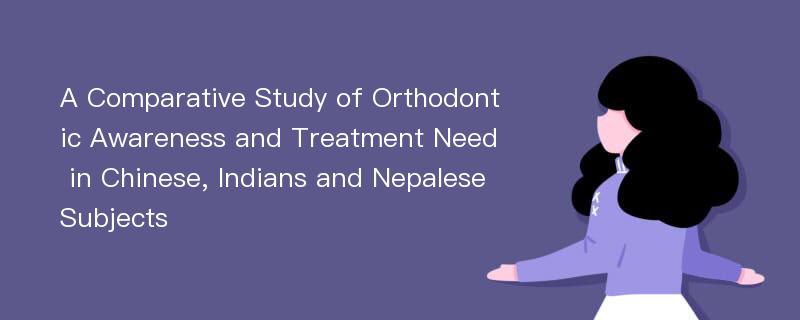
论文摘要
Introduction :-The purpose of this study was to assess the prevalence of orthodontic treatment need and the orthodontic awareness level in multi-ethnic population and understand the correlation if any between the the two and also in relation to the socio-economic status of subjects. Methods: - A sample of male and female university graduate students were taken (n = 400, age 18–22 years, Chinese =180(Chinese male CM =99.Chinese female CF=82), Indian=120 (Indian male IM=72, Indian female IF=58), Nepal=88(Nepal male NM=47, Nepal female =42) with no history of medical or any other illness, participated in the study on a voluntary basis with informed consent . The subjects participated on their will .The subjects were made to answer a simple questionnaire on orthodontic awareness. Objective treatment need was assessed based on clinical examination by a post graduate student using the(DHC-Dental Health Component ) Index of Orthodontic Treatment Need (IOTN).The socio-economic status and sex variations were also calculated. All the questionnaire were checked for completeness. The socio-economic conditions in this sample was found to be highest in order of descending Indian>Nepalese >Chinese(table1). So to prevent the country barrier in assessing income, we used Latest G.N.I from world bank Survey information and assessed the family income as low, middle and high in their respective countries and used it for assessment.Results: Out of total 400 students who participated in the study,only ( n = 388, Chinese =180(CM =98. CF=82), Indian=120 (IM=62, IF=58), Nepal=88(NM=46, NF=42) gave the completely filled questionnaires. So we considered only these 388 subjects for final analyses Socio-economic conditions was statistically insignificant . In this study we found that the displacement of teeth and overbite were the highest trait Table16 while overjet , crossbite, open bite though seen was relatively far less. All the three group considered orthodontic treatment to be expensive. Satisfaction with their smiles was in order of Nepalese>Chinese>Indians. Chinese visited orthodontist more often than Nepalese and Indians. Borderline treatment need > definitive need. Mal-occlusions were seen more in Chinese subjects than the other two but statistical difference was very minor .Acceptance to orthodontic appliance like braces was more in Indians than other two groups.Conclusions : 1.The general orthodontic awareness level in all the three multi-ethnic group was not Satisfactory. The socio-economic difference was statistically insignificant. All the three county groups considered orthodontic treatment to be expensive. The Nepalese seemed to be satisfied with their smiles than Chinese but the Indians seemed to be least satisfied Chinese were among the highest percentage who visited orthodontist when compared to their counterparts , but were not much interested in wearing braces, when compared to their other two counterparts. The mal-occlusion trait was seen highest in Chinese>Nepalese>Indians . Borderline need(G2.G3) for treatment was a little higher while the definite need was far lesser in the three groups. The displacement of teeth and overbite were the highest trait, while overjet, crossbite, open bite though seen was relatively far less. As the three country group are from developing countries where income are far less than other developed countries and also lack of sufficient knowledge for benefits of orthodontic treatment point towards results seen in this study. Their is requirement of more orthodontic awareness level to be done in society at large. As this study is done on a very small sample group ,the conclusions can not be applied on society but it serves as an important finding for need of further studies to compare the malocclusion and orthodontic treatment need and orthodontic awareness levels in various societies . Future studies should also be done to find various methods to improvise the orthodontic awareness level in different ethnicities.
